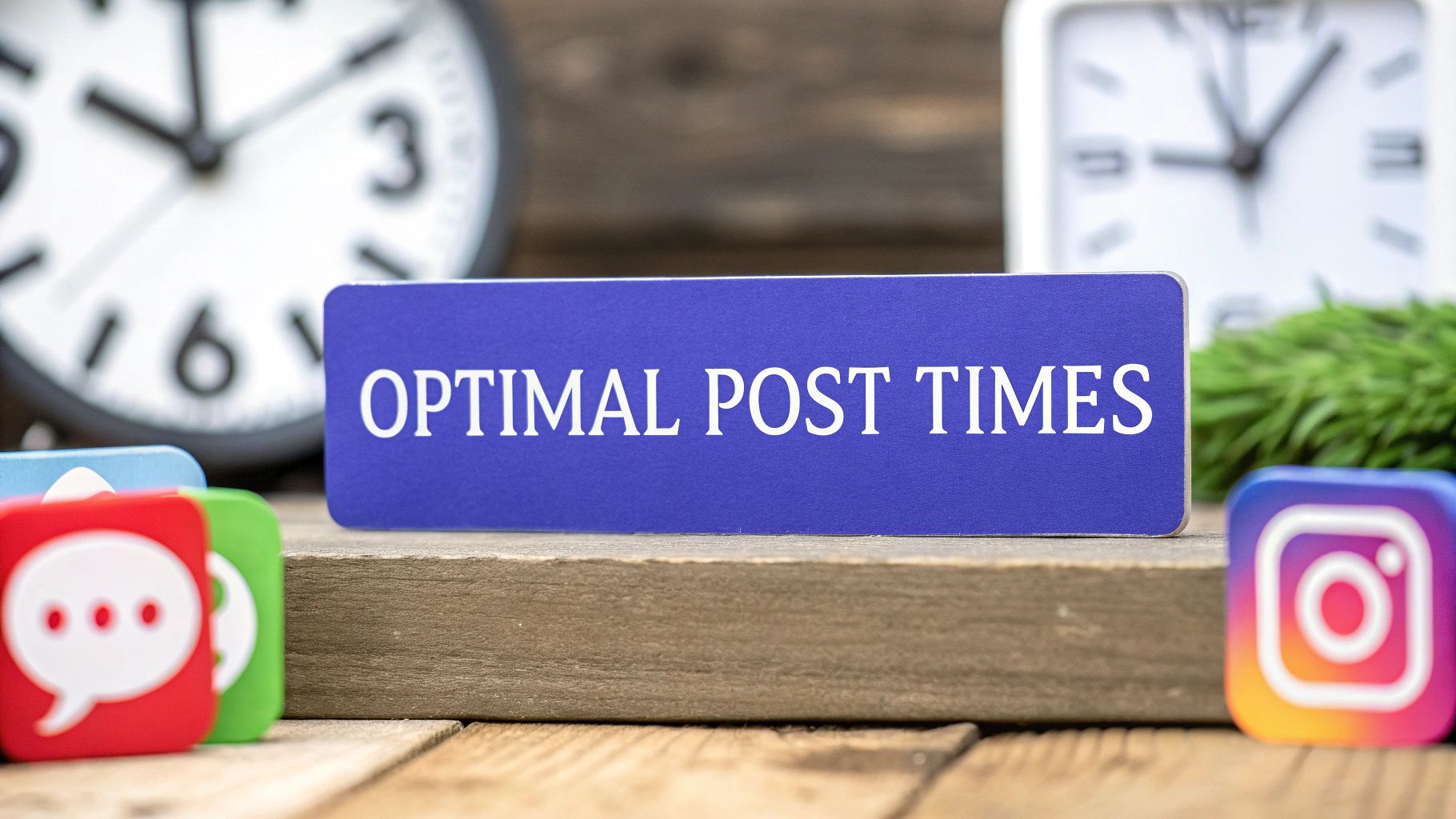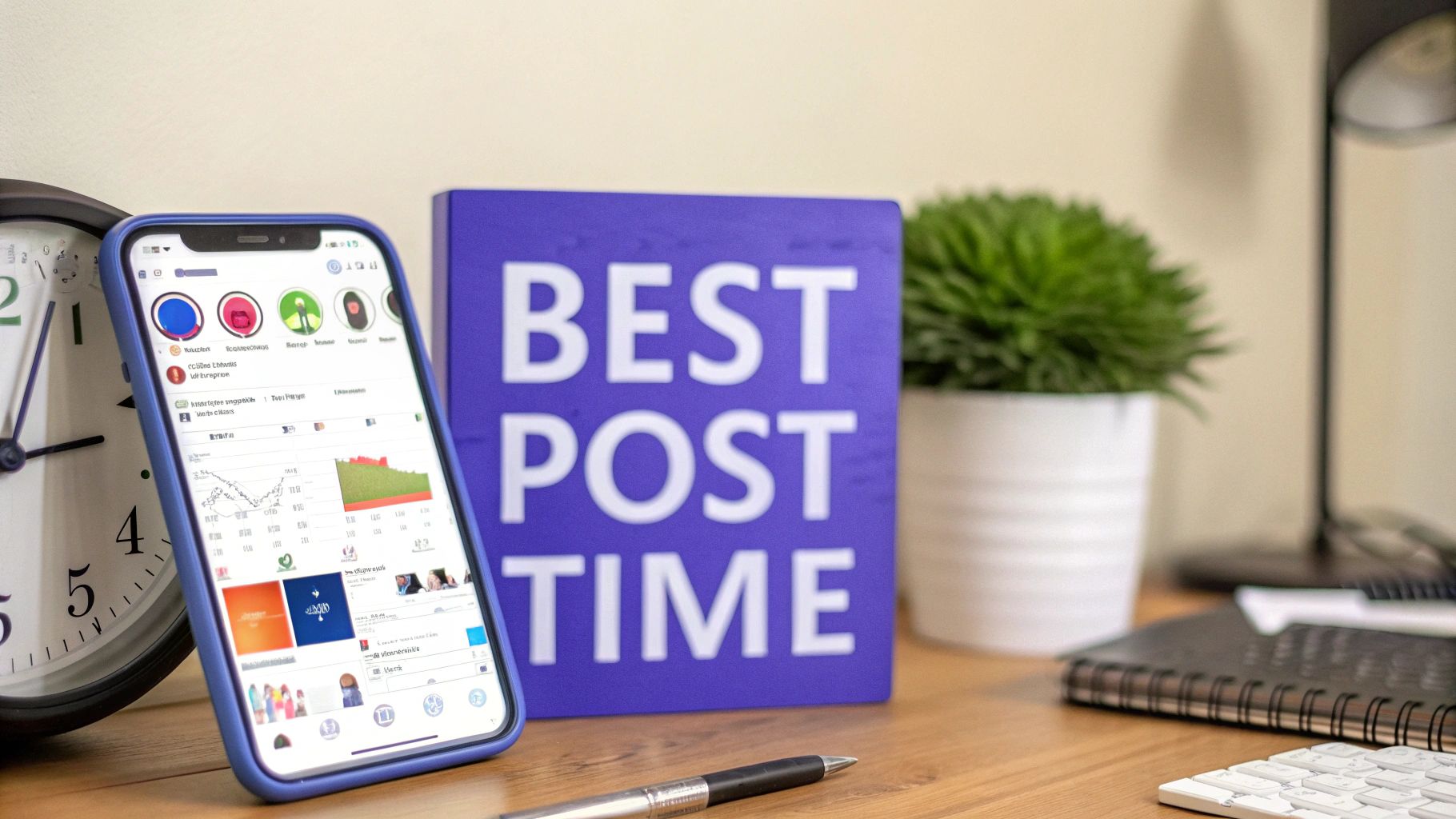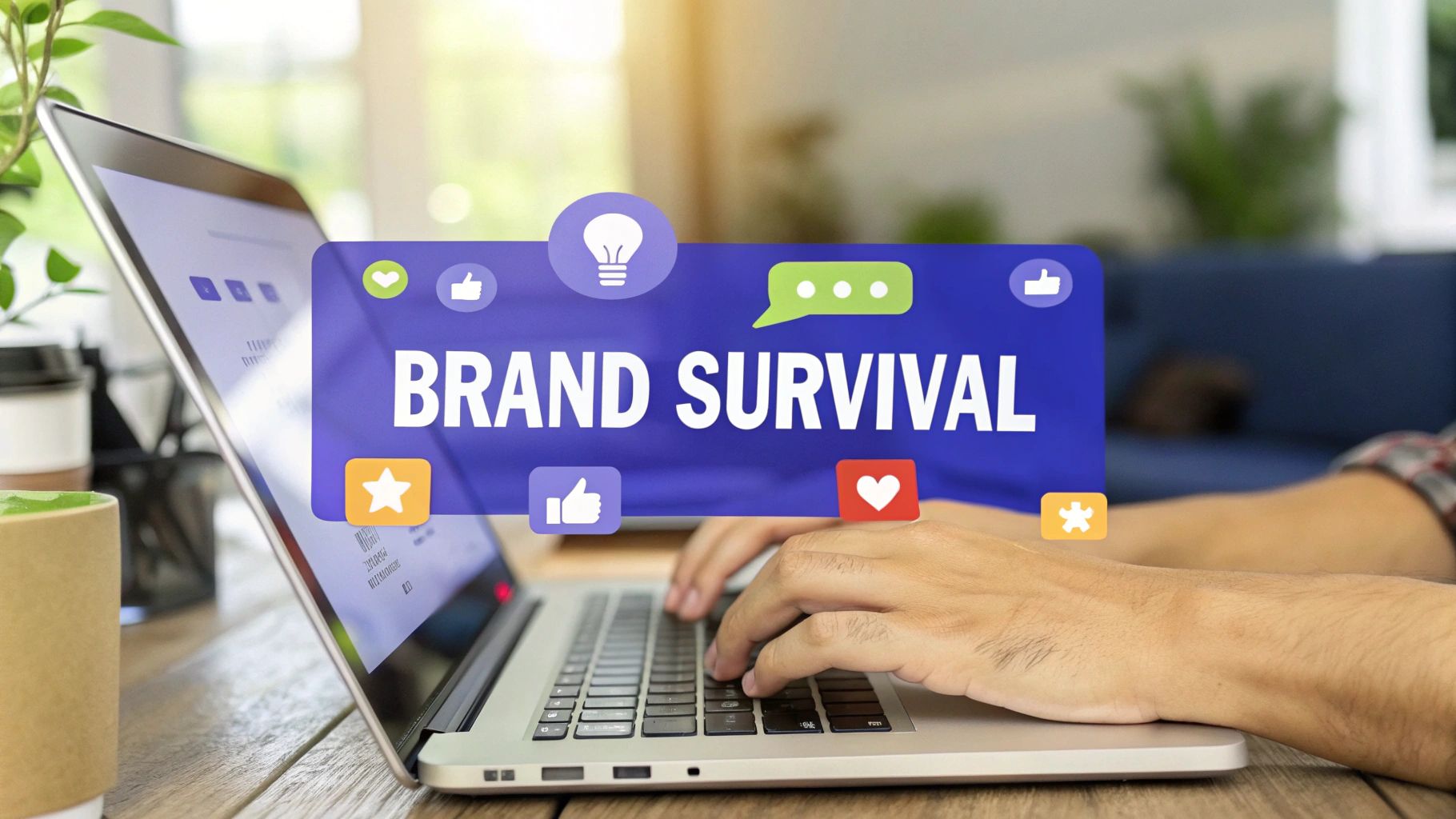You've likely seen the infographics, the ones with brightly colored charts declaring the single best time to post on social media. While these provide a basic starting point, relying on them alone is like navigating with an outdated map. The digital space is more crowded and competitive than ever, and a one-size-fits-all schedule is no longer effective. True success comes not from a universal answer, but from a strategic process tailored specifically to your brand and audience.
This guide moves beyond generic advice to provide a comprehensive framework for discovering your unique optimal posting times. We'll break down the critical factors that separate posts that get seen from those that get lost in the noise. By the end of this article, you will have a clear, actionable plan to:
- Pinpoint peak engagement windows on each major platform.
- Analyze your specific audience’s online habits and time zones.
- Use native analytics and scheduling tools to refine your strategy.
- Adapt your schedule to industry trends and current events.
The goal is to stop guessing and start making data-driven decisions that maximize every piece of content you share, turning your schedule into a powerful tool for growth.
1. Know Your Platform's Peak Hours
The foundational step to optimizing your social media schedule is recognizing that not all platforms are created equal. Each social network attracts a distinct user base with unique daily habits. The best time to post on social media isn't a universal formula; it's a platform-specific strategy. A user might scroll through LinkedIn during their morning commute but save Instagram for their evening downtime.
Aligning your posts with these peak usage windows dramatically increases your content's initial visibility. When a post receives immediate likes, comments, and shares, platform algorithms interpret it as high-quality content, pushing it to an even wider audience. Ignoring these peak hours means your content risks being buried before your followers even have a chance to see it.
Why It Works: User Behavior and Algorithms
This approach is effective because it syncs your content delivery with natural user behavior. You are meeting your audience where they are, when they are most receptive.
- LinkedIn: Professionals often check the platform at the start of their workday (around 8-10 AM) or during their lunch break (12 PM) for industry news and career development content.
- Instagram & Facebook: These platforms see high engagement during midday breaks (11 AM - 3 PM) and evening relaxation hours (7 PM - 9 PM) when users are looking for entertainment and social connection.
The following bar chart visualizes the distinct peak engagement windows for three major platforms, highlighting how user activity shifts throughout the day.
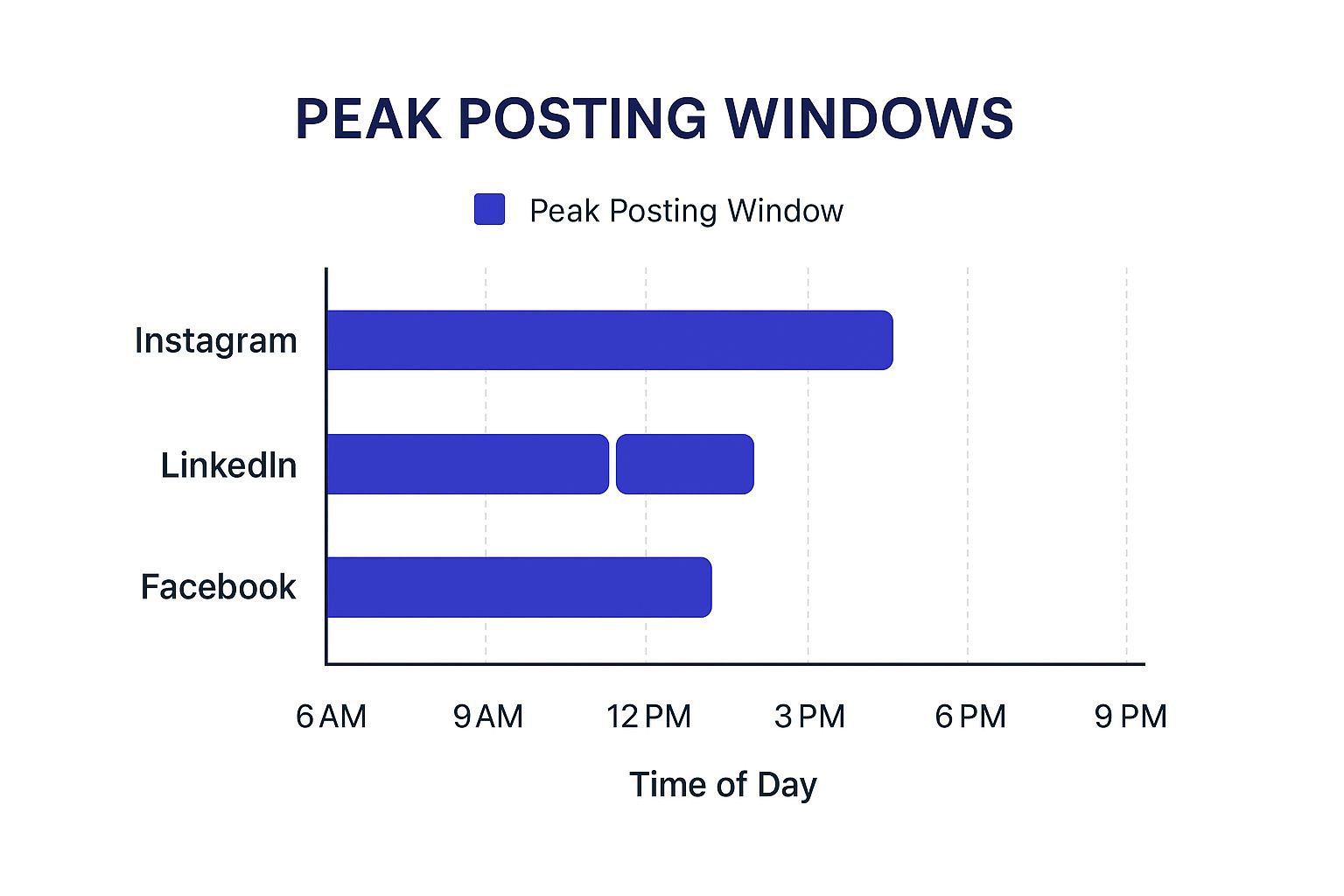
This visualization clearly shows there is minimal overlap in peak times, reinforcing the need for a tailored, platform-specific posting schedule. For instance, a post at 9 AM might excel on LinkedIn but get lost on Facebook, where peak activity happens hours later. This data-driven approach is the first and most critical step in defining the best time to post on social media for your brand.
2. Analyze Your Audience's Online Behavior
While platform-wide data provides a great starting point, the most powerful insights come from your own followers. Understanding when your specific audience is most active online is more valuable than any generic advice. The best time to post on social media for your brand is ultimately determined by the unique habits of the people who have already chosen to follow you.
Drilling down into your own analytics allows you to move beyond broad assumptions and create a truly customized posting strategy. A B2B software company will have a vastly different audience activity pattern than a direct-to-consumer fashion brand. By studying your followers' demographics, time zones, and daily routines, you can pinpoint the precise moments they are most likely to engage with your content.
Why It Works: Precision and Personalization
This method is effective because it is tailored specifically to your community. You are not just posting during general peak hours; you are posting during your peak hours, aligning with the real-world schedules of your target market.
- B2B Brands: These companies often find success posting during standard work hours (e.g., 9 AM - 4 PM) when their professional audience is at their desks and seeking industry-related information.
- Food Bloggers: Posting just before mealtimes, such as 11 AM for lunch inspiration or 5 PM for dinner ideas, can capture an audience when they are actively thinking about what to eat.
- Fitness Brands: Engagement often spikes in the early morning (6 AM - 8 AM) before the workday begins and in the evening (6 PM - 8 PM) when people are hitting the gym or winding down.
This level of audience analysis transforms your strategy from a shot in the dark to a data-driven science. To implement this, dive into your social media analytics tools on platforms like Instagram Insights or Facebook Business Suite. Look for reports that show when your followers are most active on a daily and weekly basis. This data is the key to unlocking the true best time to post on social media for maximum impact and connection with your audience.
3. Leverage Native Analytics Tools
While industry benchmarks provide a great starting point, the most powerful data for determining the best time to post on social media comes directly from your own audience. Social media platforms offer robust, built-in analytics tools that reveal precisely when your followers are most active and engaged. This data is hyper-specific to your account, making it far more accurate than generalized statistics.
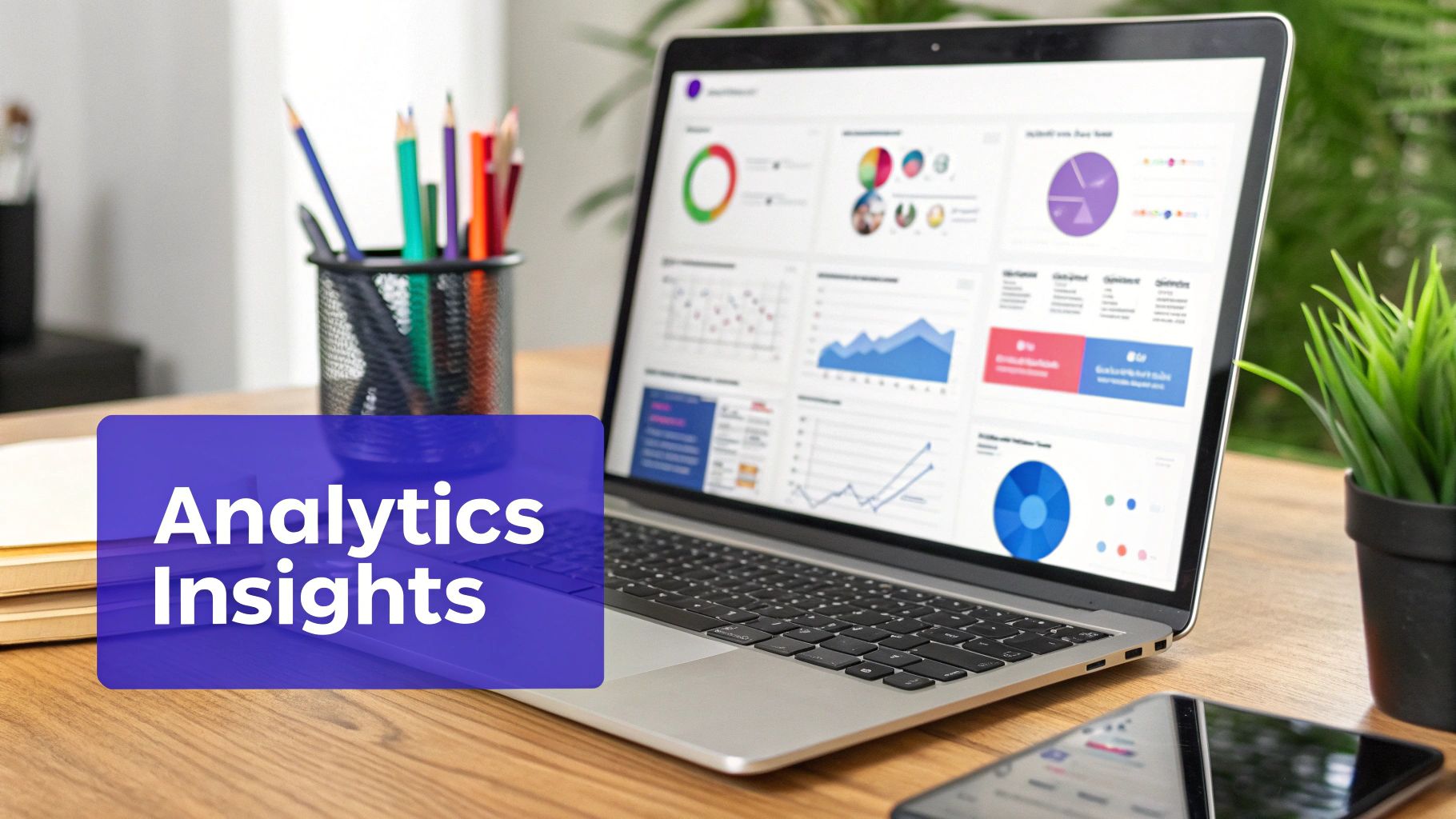
Tapping into these native insights allows you to move beyond assumptions and make data-driven decisions tailored to your community's unique behavior. By analyzing your actual follower activity, you can identify patterns that are specific to your niche, demographic, and content style, giving you a significant competitive advantage. Ignoring this personalized data is like navigating without a map; you might be heading in the right general direction, but you are missing the most efficient route.
Why It Works: Personalized Data and Direct Feedback
This strategy is effective because it uses first-party data, which is the most reliable information you can get. You are analyzing the proven habits of people who have already chosen to follow you, ensuring your schedule aligns with their online presence.
- Instagram Insights: Available on Business or Creator accounts, this tool shows follower activity broken down by both the day of the week and the hour of the day, providing a clear heatmap of your audience's peak engagement times.
- Facebook Page Insights: Under the "Audience" tab, you can find a detailed graph showing when your fans are online. This helps you schedule posts for maximum initial reach among your existing followers.
- LinkedIn Page Analytics: The "Followers" tab in your page analytics provides demographic data and highlights when your professional audience is most likely to see and interact with your updates.
For a deeper dive into making this data actionable, you can explore guides on building a comprehensive social media analytics dashboard on postsyncer.com to centralize these insights. Ultimately, using native analytics transforms your posting strategy from a guessing game into a precise, feedback-driven process. It is the most direct way to understand your community and find the best time to post on social media for your specific brand.
4. Consider Time Zones for Global Audiences
When your audience spans continents, a single "peak time" becomes an illusion. The best time to post on social media for your New York followers is the middle of the night for your audience in London or Sydney. Ignoring this reality means sacrificing engagement from a significant portion of your international community, effectively telling them their interaction is less valued.
A global content strategy requires a more sophisticated approach than a local one. Instead of one optimal posting time, you must identify several key windows that cater to your largest geographic segments. Brands that successfully manage this, like Netflix or Coca-Cola, don't just post content; they orchestrate a global release schedule that respects and engages diverse audiences in their local time. This prevents your content from being immediately buried for entire continents worth of followers.
Why It Works: Maximizing Global Reach
This method is rooted in respectfully acknowledging and adapting to your audience's diverse geographical distribution. You are strategically placing your content to be visible during the prime engagement hours of multiple key markets, rather than just one.
- For B2B Brands: A tech company with clients in North America and Europe might post important updates twice: once for the morning peak in the EU (e.g., 3 AM ET) and again for the morning peak in the US (e.g., 9 AM ET).
- For D2C Brands & Influencers: An apparel brand like Nike might launch a new product by posting at times corresponding to evening leisure hours in their top three markets, such as North America, Western Europe, and East Asia, ensuring maximum visibility for each launch phase.
By segmenting your audience by location, you can create a posting schedule that rotates through these different time zones. This ensures that over the course of a week, every major segment of your audience has a chance to see your content fresh in their feed, leading to higher initial engagement and better algorithmic performance worldwide. This targeted timing is a crucial element in finding the best time to post on social media for a truly global brand.
5. Test and Track Performance Consistently
While general best practices provide a strong starting point, the ultimate best time to post on social media for your brand is unique to your audience. This is where systematic testing and performance tracking become indispensable. This method involves moving beyond industry benchmarks and using your own data to pinpoint the exact times your content resonates most powerfully with your specific followers.
The core principle is to treat your posting schedule like a scientific experiment. By methodically trying different time slots and meticulously measuring the results, you can replace assumptions with concrete, data-driven insights. This continuous feedback loop ensures your strategy evolves alongside your audience's habits, keeping your engagement rates high and your content visible. Platforms like Buffer and HubSpot have built their entire social media reputations on this data-first approach, proving its effectiveness time and again.
Why It Works: Data-Driven Refinement
This strategy is powerful because it’s tailored to your unique circumstances. An e-commerce brand targeting Gen Z on TikTok will have a vastly different optimal schedule than a B2B software company on LinkedIn. Consistent testing uncovers these nuances.
- Establish a Baseline: Begin by posting at the generally recommended peak times for each platform for a few weeks to gather initial performance data.
- Isolate Variables: Test one new time slot at a time. For example, if you normally post at 9 AM, try posting the same type of content at 11 AM for a week and compare the engagement rates.
- Track Key Metrics: Focus on engagement rate (likes + comments + shares ÷ followers) rather than just vanity metrics like total likes. Also, track clicks, reach, and follower growth to get a complete picture.
Systematic testing requires organization and a clear plan. A well-structured social media calendar is essential for scheduling your test posts and documenting the outcomes. To build an effective framework for your experiments, you can learn more about creating a social media calendar on postsyncer.com. This documented approach transforms guesswork into a reliable, repeatable process for discovering the best time to post on social media for maximum impact.
6. Understand Industry-Specific Patterns
Beyond platform-specific habits, the best time to post on social media is heavily influenced by your industry. An audience's professional life, daily routines, and content needs are often dictated by the sector they belong to, creating unique windows of opportunity for engagement. A B2B tech company will find its audience active at different times than a B2C fashion brand.
Tailoring your posting schedule to these industry-specific rhythms allows you to connect with users when they are most likely to be seeking your type of content. A healthcare worker might scroll for professional development resources during their lunch break, while a student looks for educational tips after school. Ignoring these nuances means you could be posting valuable content when your target audience is completely offline or mentally checked out.
Why It Works: Audience Lifestyle and Content Relevance
This strategy is powerful because it aligns your brand with the specific daily cadence of your target demographic. You move from a general approach to a highly contextual one, meeting your audience during moments relevant to their profession or lifestyle.
- B2B Industries (e.g., Finance, Tech): Engagement often peaks during the workday, particularly during morning commutes (8-10 AM) and lunch breaks (12-2 PM) as professionals check industry news and updates.
- B2C Industries (e.g., Restaurants, Entertainment): Activity surges just before mealtimes (11 AM - 1 PM, 4-6 PM) for restaurants and during evening leisure hours (7-10 PM) for entertainment and retail, when consumers are making purchasing decisions or relaxing.
- Healthcare & Education: These sectors often see high engagement during non-traditional hours. Healthcare professionals might be most active after late shifts, while the education sector sees a spike in activity from parents and students in the late afternoon and evening (3-8 PM).
By understanding these patterns, you can pinpoint the best time to post on social media with greater precision, ensuring your message lands when it's most likely to be received and acted upon. This targeted timing makes your content feel more relevant and less intrusive.
7. Use Social Media Scheduling Tools
Manually posting content at precise, predetermined times is not only tedious but also prone to human error. Social media scheduling tools are professional-grade platforms that automate this process, ensuring your content goes live at the best time to post on social media, even outside of your working hours. These tools go beyond simple automation; they offer advanced analytics, AI-powered timing suggestions, and a centralized hub to manage complex content calendars across multiple social networks.

Using a scheduler transforms your strategy from reactive to proactive. Instead of scrambling to post in the moment, you can batch-create content and schedule it weeks or even months in advance. This frees up valuable time to focus on other critical tasks, such as community engagement, trend monitoring, and performance analysis, which are essential for long-term growth.
Why It Works: Consistency and Data-Driven Optimization
Scheduling tools enforce consistency, a key factor that social media algorithms favor. By maintaining a steady stream of high-quality content at optimal times, you signal to platforms like Instagram and LinkedIn that you are a reliable and active creator, which can boost your organic reach.
- Hootsuite & Sprout Social: These comprehensive platforms are ideal for teams, offering bulk scheduling, collaborative workflows, and in-depth analytics suites that track performance and ROI across all channels.
- Later & Buffer: Known for their user-friendly interfaces, these tools excel at visual planning. Later is an Instagram-first scheduler with powerful timing insights, while Buffer pioneered the concept of a simple content queue for consistent posting.
Many of these platforms offer features that automatically suggest the best times to post based on your account's unique historical engagement data. This removes the guesswork and helps you capitalize on your specific audience's activity patterns. For a deeper look into the available options, you can explore the top social media scheduling tools and see how they can streamline your workflow. By leveraging these tools, you ensure your strategy for finding the best time to post on social media is both efficient and highly effective.
8. Account for Current Events and Seasonal Trends
A truly optimized social media schedule is dynamic, not static. The world outside your content calendar significantly impacts user behavior, and the best time to post on social media often shifts based on current events, seasonal changes, and major cultural moments. Ignoring these external factors can make your brand appear tone-deaf or cause your message to be completely overlooked.
Adapting your posting times to the real-world context is a hallmark of an advanced social media strategy. This means pausing scheduled promotional content during a major news crisis or, conversely, strategically timing posts to join a positive global conversation. This agility demonstrates social awareness and allows you to connect with your audience in a more relevant and timely manner, capitalizing on moments when their attention is already focused on a specific theme or event.
Why It Works: Relevance and Audience Sensitivity
This approach is powerful because it aligns your brand with the immediate consciousness of your audience. You are participating in the same world they are, which builds a stronger, more authentic connection.
- Holiday & Seasonal Peaks: Retail and e-commerce brands can find new peak engagement windows by posting during heightened shopping periods like Black Friday or back-to-school season. User activity on platforms like Pinterest and Instagram often surges as people look for inspiration and deals.
- Cultural Moments: Events like the Super Bowl or the Oscars create unique, temporary engagement windows. Oreo's famous "You can still dunk in the dark" tweet during the 2013 Super Bowl blackout is a classic example of capitalizing on a shared, real-time experience.
- News and Current Events: In times of tragedy or significant breaking news, user attention is diverted. Pausing your regular content shows respect and sensitivity, preventing your brand from seeming out of touch. Resuming your schedule once the public conversation has shifted is key.
Successfully navigating these fluctuations requires preparation and a flexible mindset. A rigid, automated schedule cannot account for the nuance of human experience. By staying informed and adaptable, you can fine-tune your timing to find the best time to post on social media for any given day or week, not just a generic average.
8-Point Best Posting Time Strategy Comparison
| Strategy | Implementation Complexity 🔄 | Resource Requirements ⚡ | Expected Outcomes 📊 | Ideal Use Cases 💡 | Key Advantages ⭐ |
|---|---|---|---|---|---|
| Know Your Platform's Peak Hours | Medium 🔄 | Low ⚡ | Higher organic reach and engagement 📊 | General posting schedule optimization for multiple platforms | Maximizes algorithm favorability and engagement rates ⭐ |
| Analyze Your Audience's Online Behavior | High 🔄 | Medium ⚡ | More relevant, targeted engagement 📊 | Brands needing customized timing per audience | Tailored approach increasing audience connection ⭐ |
| Leverage Native Analytics Tools | Medium 🔄 | Low ⚡ | Accurate real-time insights 📊 | Users with access to platform-specific data | Free, up-to-date audience behavior info ⭐ |
| Consider Time Zones for Global Audiences | High 🔄 | High ⚡ | Expanded global reach and engagement 📊 | Brands with international or multi-region audiences | Prevents audience neglect, demonstrates global awareness ⭐ |
| Test and Track Performance Consistently | High 🔄 | Medium ⚡ | Optimized posting strategy over time 📊 | Data-driven marketers aiming for continuous improvement | Enables custom, validated timing strategies ⭐ |
| Understand Industry-Specific Patterns | Medium 🔄 | Low-Medium ⚡ | Industry-tailored timing insights 📊 | Businesses in niche or sector-specific markets | Identifies unique time slots, competitive edge ⭐ |
| Use Social Media Scheduling Tools | Medium 🔄 | Medium-High ⚡ | Consistent posting and efficient management 📊 | Teams managing multiple platforms and campaigns | Saves time, offers AI suggestions, enhances cross-platform control ⭐ |
| Account for Current Events and Seasonal Trends | High 🔄 | Medium ⚡ | Increased relevance and engagement during events 📊 | Brands sensitive to timing around events and holidays | Capitalizes on trends, avoids poor timing situations ⭐ |
Turn Your Timing from a Guess into a Strategy
Throughout this guide, we've dismantled the myth of a single, universal "best time to post on social media." The reality is far more nuanced and powerful. True success doesn't come from a static, one-size-fits-all schedule. It emerges from a dynamic, data-driven strategy tailored specifically to your brand, your audience, and your unique goals.
Moving beyond generic advice is the first and most critical step. Instead of blindly following broad industry benchmarks, the most successful social media managers treat timing as a science. They combine platform-specific peak hours with a deep, analytical understanding of their own audience's digital pulse. This is where guesswork ends and strategy begins.
Your Actionable Roadmap to Mastering Social Media Timing
To translate the insights from this article into tangible results, focus on building a sustainable, iterative process. Your journey from a reactive poster to a proactive strategist involves a few core pillars. Think of it as a continuous improvement cycle for your social media presence.
Here is your checklist for turning timing into a core competitive advantage:
- Establish Your Baseline: Start by implementing the recommended posting times for each platform you use. This provides an immediate, data-backed foundation to build upon and test against.
- Dive Deep into Your Analytics: Make it a weekly or bi-weekly habit to review your native analytics on Instagram, Facebook, TikTok, and LinkedIn. Go beyond surface-level likes and look for patterns in reach, clicks, and follower activity by time of day. Where are the unexpected spikes?
- Segment and Test Systematically: Don’t just test random times. Create a hypothesis. For example, "I believe my B2B audience on LinkedIn is more active during their lunch break (12-1 PM) than in the early morning." Test this for two weeks, track the results, and make a data-informed decision.
- Embrace Automation with Purpose: Leverage a social media scheduling tool to execute your strategy consistently. This frees you from the manual task of posting in real-time, especially when targeting audiences across different time zones. It also centralizes your performance data for easier analysis.
The Long-Term Impact of Strategic Timing
Mastering the best time to post on social media is more than just an optimization hack; it's a fundamental shift in how you approach your content distribution. When your posts consistently land in front of your audience at the precise moment they are most receptive, the benefits cascade across your entire marketing funnel.
You will see higher engagement rates, which signals to platform algorithms that your content is valuable, leading to greater organic reach. This increased visibility drives more qualified traffic to your website, generates more leads, and ultimately strengthens your brand's authority and connection with its community. By treating your posting schedule with the strategic importance it deserves, you ensure every piece of content you create has the maximum possible opportunity to succeed.
Ready to stop guessing and start strategizing? PostSyncer's intelligent scheduling tools analyze your unique audience engagement patterns to recommend the perfect posting times for you. Take the complexity out of finding the best time to post on social media and let our AI-powered platform ensure your content always hits its mark by visiting PostSyncer to start your journey.
